Sharon takes a look at all the new products and colors available from Superior Threads as she visits with Bob Purcell. Wait until you see how many new colors are in Alex's MasterPiece line!
Sharon takes a look at all the new products and colors available from Superior Threads as she visits with Bob Purcell. Wait until you see how many new colors are in Alex's MasterPiece line!
 |
|
Every odd calendar year, hundreds of quilters from around the state of Colorado anxiously await the day when they can see their own quilts hanging in the State Capitol Building in Denver. Before the show is even open to the public, however, numerous volunteers spend many long and sometimes stressful hours working to ensure that the quilt installation goes without a hitch. Join us as we share a behind-the-scenes look at what it takes to organize and hang the biennial Capitol Quilt Show, organized by the Colorado Quilting Council.
Learn more about how much work it takes to put on this incredible show HERE. |
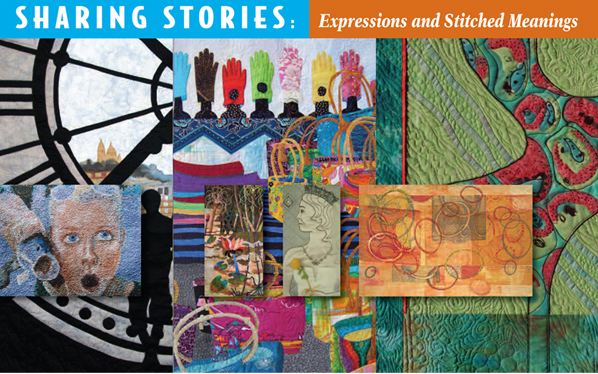
Forget all preconceptions about the quilts of yesteryear. Using a wide range of fabrics, media, and techniques, today's quilters are producing works of art worthy of hanging in the most prominent of galleries.
The Studio Art Quilt Associates (SAQA) is offering a number of opportunities for you to view works that are pushing this textile tradition into the 21st century. at the Front Porch Gallery in Carlsbad, CA.
Front Porch Gallery
Opening Reception: Saturday, July 9 from Noon- 2pm
Exhibit Dates: July 9 - September 4, 2011
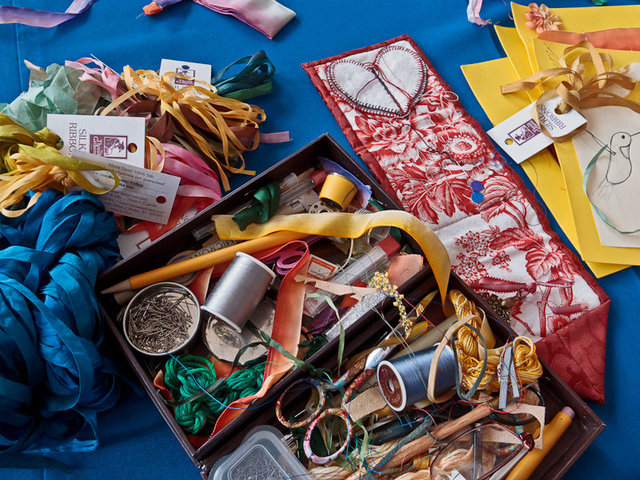
Photo by Gregory Case Photography
Wendy Grande, our featured artist on Episode 813, shares some helpful hints to guide you in stitching your own luminous, silk-ribbon creations from her book book Ribbon Applique: A Primer.
Do you collect vintage sewing paraphernalia? What do you collect? Here's a fun collection from the 2011 San Mateo County Fair in California. Do you recognize any of them?
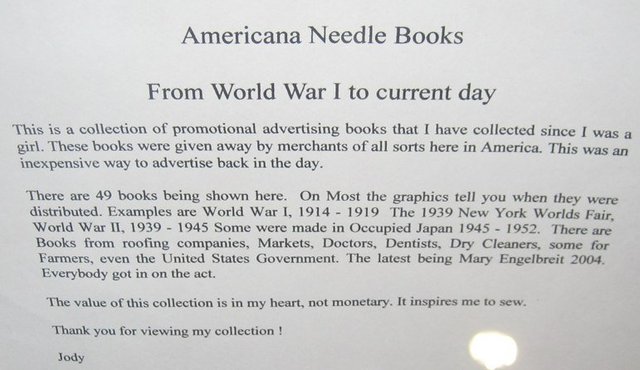
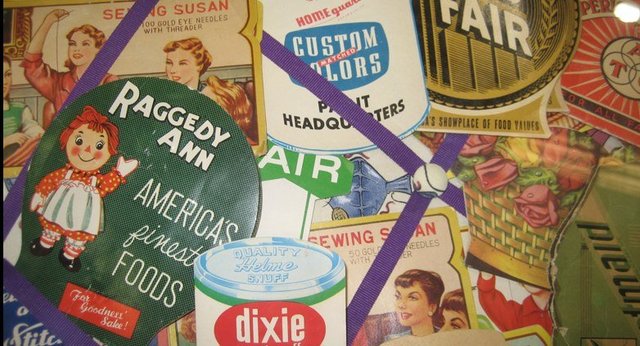
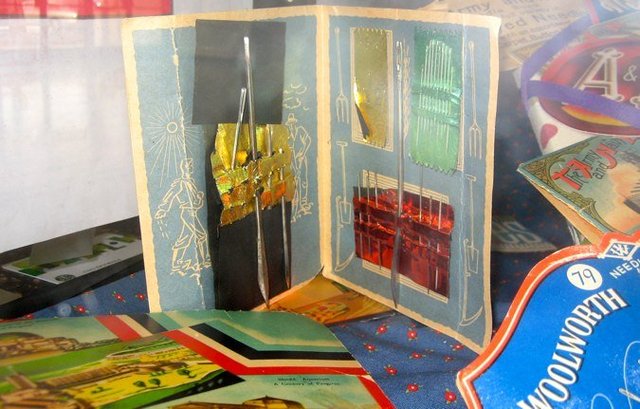
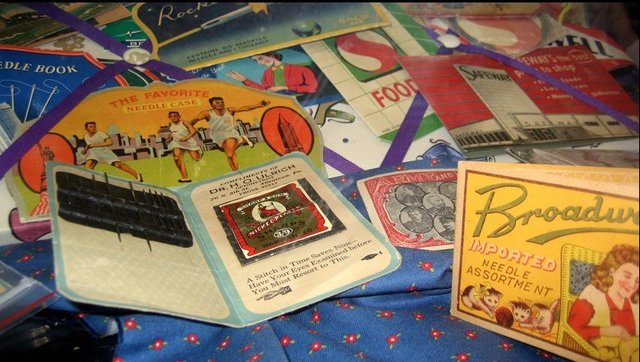
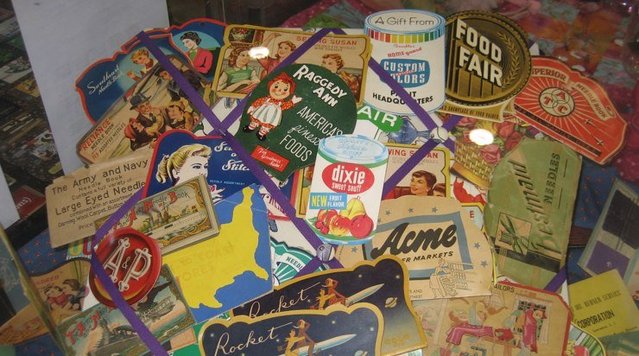
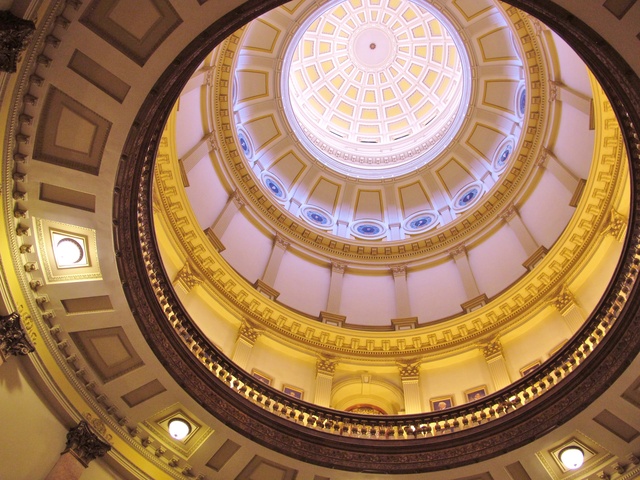
View of the Rotunda, State Capitol Building, Denver, CO. Photo by Lilo Bowman
Many Hands Build the Capitol Quilt Show
by Lilo Bowman
The Capitol Quilt Show at the State Capitol Bldg., Denver, CO
June 6-August 19, 2011
Monday-Friday 7:30am-5:00pm
Closed on Weekends
Every odd calendar year, hundreds of quilters from around the state of Colorado anxiously await the day when they can see their own quilts hanging in the State Capitol Building in Denver. Before the show is even open to the public, however, numerous volunteers spend many long and sometimes stressful hours working to ensure that the quilt installation goes without a hitch. Join us as we share a behind-the-scenes look at what it takes to organize and hang the semi-annual Capitol Quilt Show, organized by the Colorado Quilting Council.
This year marks the 23rd show of quilts at the Denver State Capitol Building, making the Capitol Quilt Show one of the longest continually running quilt shows in the United States.
Preparation for the show begins in the fall of the previous (even) year, with the guild chairperson attending many Capitol Building advisory committee meetings. For the 2011 show, as well as for the past two shows, this busy guild representative has been Karen Hadfield. It is at these meetings that the chairperson works with the committee to determine the dates for the show, as well as the number of quilts that will be displayed.
Once the show dates are chosen, the real "down in the trenches" work begins: getting the word out to all Colorado quilters. The call for entries goes out in mid-January of the show year. Entries are accepted on a first-come, first-served basis, and since only 270 quilts were allowed in the show this year, submitting an application early was a must for any quilter wanting to have her/his quilt included. With only one quilt allowed per person or group, deciding which piece to enter can be a challenge.
To be eligible for entry, the quilt must "live" in Colorado or have been made by a Colorado quilter. The quilt, fitted with the usual 4" sleeve, must fall within a specified size range; due to the nature of the venue, extremely small or large quilts cannot be accepted. As quilts sometimes are suspended 20' - 30' in the air, a very small quilt would not be visable. On the other hand, the building only has a few locations suitable for the display of a very large quilt. Organizer Karen Hadfield opted to keep the size restrictions to 270" total to offer more hanging options.
As the quilt entries arrive, Karen uses the required photos to sort the quilts according to style, size, theme, and so on. She says that it is always fun discovering which quilts have been submitted, and that determining how and where the quilts will be hung is her favorite part of the job. Keeping similar styles together is her goal, but ultimately she wants the show to have an overall, cohesive feel. To make her task easier, Karen uses a large schematic of each of the three floors of the Capitol, as well as nearby corridors. Once a quilt entry has been received, it is assigned a number and logged into a spreadsheet that lists the number, name of the quilt, the maker, and the location where the quilt will hang. This process is repeated for all 270 quilts.
One group, "The Material Girls," requested that their quilts be hung together. All the ladies in this bee exchanged 2" strips of assorted reproduction fabrics and then made quilts using the fabrics that they received in the swap.The quilts are all individual in feel, but have a wonderful, unifying factor in the fabrics. Karen decided to hang all of these quilts along the first-floor corridor of the Capitol's East Wing.
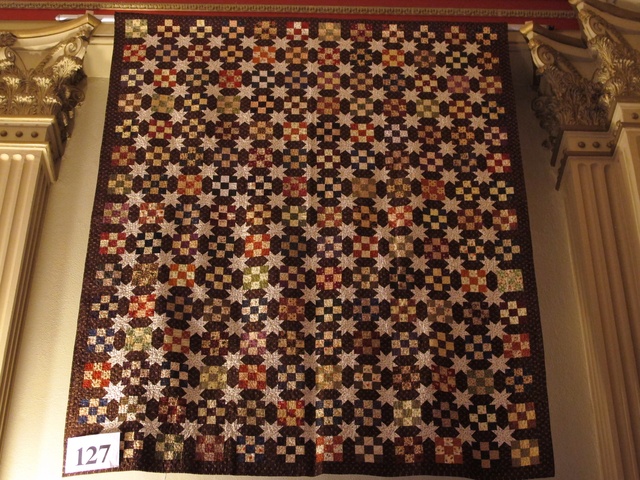
Stars & Nines by Anissa Arnold, Lakewood, CO. Photo by Lilo Bowman
Quilts relating to the state are displayed on the south side of the first floor, in front of the Governor's office, but beyond that, Karen says that the quilts usually help determine where they should hang.
Several weeks before the actual "hanging day," things really go into high gear. For one week, quilt shops around the state, as well as the Rocky Mountain Quilt Museum in Golden, become drop-off points for quilters to bring their pieces. As an alternative, quilters have the option to ship their quilts to Karen's home, or to drop them by personally. As a result, almost overnight, Karen's home becomes a quilt warehouse! For identification and protection, all quilts must be enclosed in a cotton bag, marked with the name of the quilt, and the name and address of the maker.
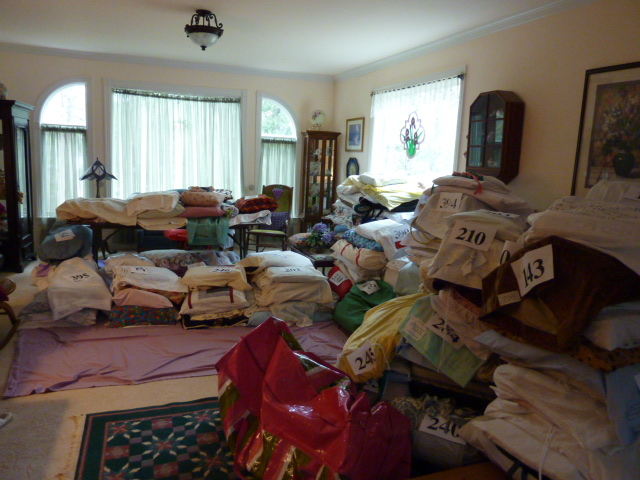
Karen's living room filled with quilts. Photo courtesy of Karen Hadfield
Two weeks before "hanging day," all the quilts are brought to Karen's home to be tagged with two sets of numbers: one on the quilt and on the outer,cotton bag. (This makes it easier to match the quilt and its cover when the show comes down.) At this time, the quilts also are sorted by floor, with the 100s earmarked for the first floor, 200s for second, and so on.

Quilts stacked and ready for the Sort and Shoot. Photo courtesy of CQC
Two days before the "hanging," the quilts are transported (via volunteer cars) to a nearby church for what is playfully referred to as "Sort and Shoot." Each quilt is hung, photographed, and tagged with a number label. This two-day event requires many hands from the Colorado Quilting Council Guild. The guild offers for sale individual quilt photographs or a CD of the entire show.
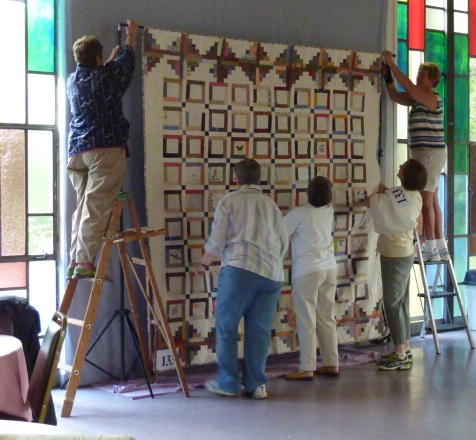
Hanging a quilt. Photo courtesy of CQC
Once the quilts have been through the "Sort-and-Shoot" process, they are stacked by number and location in four vehicles that will deliver them to the State Capitol the next day...and everyone sighs with relief that a major portion of the show preparation has been completed. While the show has run many years without any major glitches, occasionally fate steps in as a reminder that "we" are not always in control.
As it so happened, this year there were two "oh-no!" moments. One quilt entry somehow slipped through the entire initial check-in process without a hanging sleeve. The person submitting the quilt was not a seamstress; the quilt top was hand stitched by her mother, and had been quilted by another individual. During all the shuttling around, the sleeve never made it to the back of the quilt. Fast-thinking volunteers made an emergency trip to a local quilt store, and overnight, one of the guild members hand stitched a sleeve to the back of the quilt.
The "drama" continued when it was discovered at around 9:00 pm that one of the transport vehicles, loaded up about 150 quilts and at least an hour from the Capitol, would not start. Several hours of high anxiety later, two alternate vehicles were found and the quilts were transferred safely.
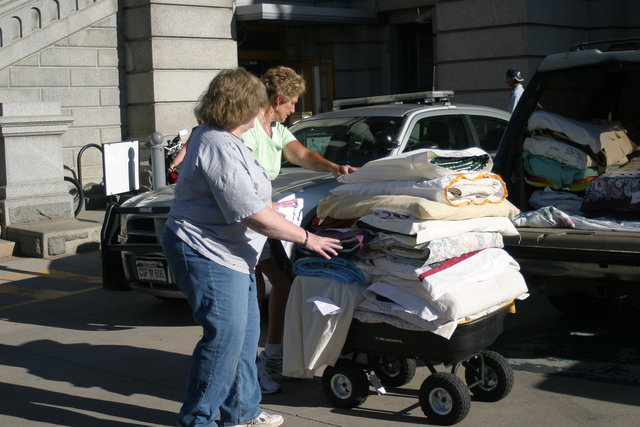 Volunteers Bringing in the quilts. Photo courtesy of CQC
Volunteers Bringing in the quilts. Photo courtesy of CQC
"Hanging day" dawns early, as the guild has just one day to hang the entire collection of 270 quilts. About thirty volunteers arrive at the Capitol by 7:00 am, eager to get started. Once again, Karen has the process organized to make the day run as smoothly as possible. The local staging company is there with men, ladders, and two cherry pickers. The quilts are brought into the building on small carts, and distributed by floor and location throughout the building. Small teams of volunteers man each area of the building to ensure that the quilts are in sight throughout the day.
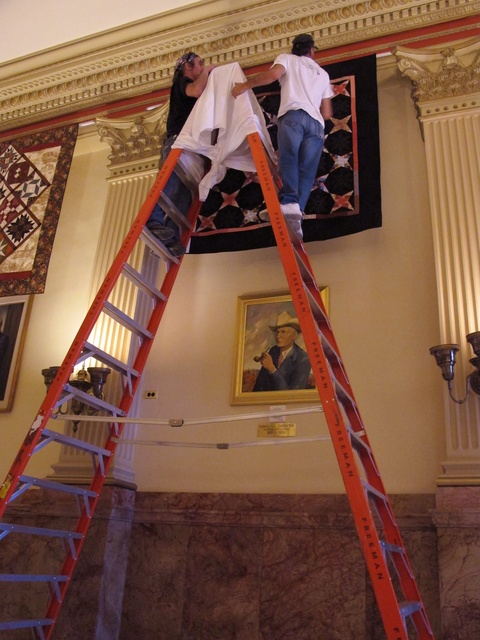
Hanging a quilt. Photo by Lilo Bowman
Hanging the show is a long and exhausting process, but through it all, the volunteers are cheerful and love sharing information about quilts and quilting with visitors enthralled by the process. As you walk through the building, taking in the entire show, the overall impression is just mesmorizing. It's hard to believe that this stunning 1890s building, built of Colorado white granite and filled with rare rose onyx from Beulah, CO, and gleaming brass fixtures, could be more stunning...but, once those quilts are in place, it truly is a sight to behold. Good work, Karen and members of the Colorado Quilting Council. You definitely deserve a huge pat on the back.
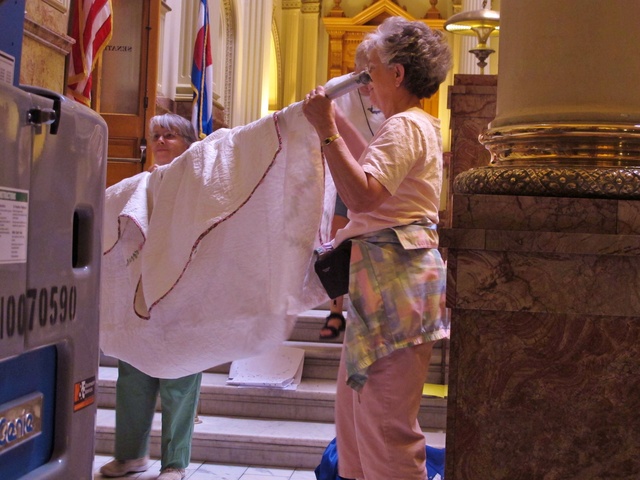
Waiting to hang a quilt. Photo by Lilo Bowman
To learn more about the Colorado Quilting Council, click here.
To see more of the installation-day process, watch the slide show here.
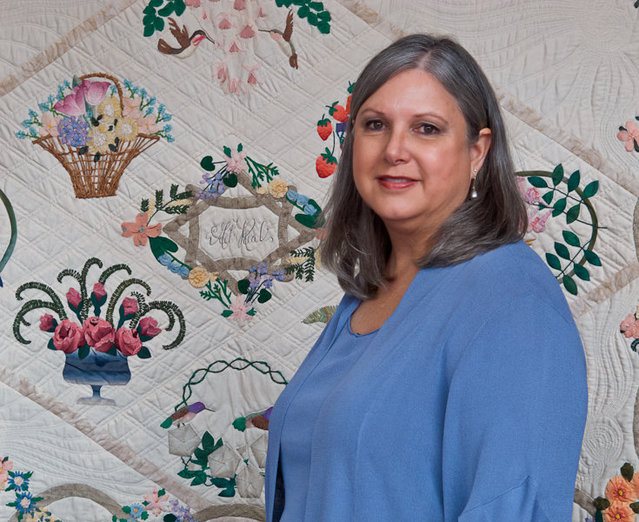
Photo by Gregory Case Photography
Join us in Episode 813 as teacher, author, and appliqué artist extraordinaire Wendy Grande uses ribbon as other quilters use fabric to create her beautiful appliquéd designs. In this episode, Wendy joins Alex and Ricky on location at Miramont Castle in Manitou Springs, CO, in a show and tell of her amazing work, both quilts and wedding gowns, and to share her favorite techniques and tools - ribbons, needles, thread, and markers - for achieving flawless results.
Then Museum Administrator Karen Converse takes us on a tour of the 166-year-old castle, revealing some quirky facts and finds in the site's colorful history. You won't want to miss this one!
Take a look at Episode 813 Enhance Your Applique Repertoire...with Ribbon! and Wendy Grande. The Episode begins June 20!
Margo had a video going of the Cruise by Quilting. The Cruise company had a live feed of the action on the dock. TQS member, BrinkofNorway, was there to create a Drive by Quilting. Watch the fun in action.